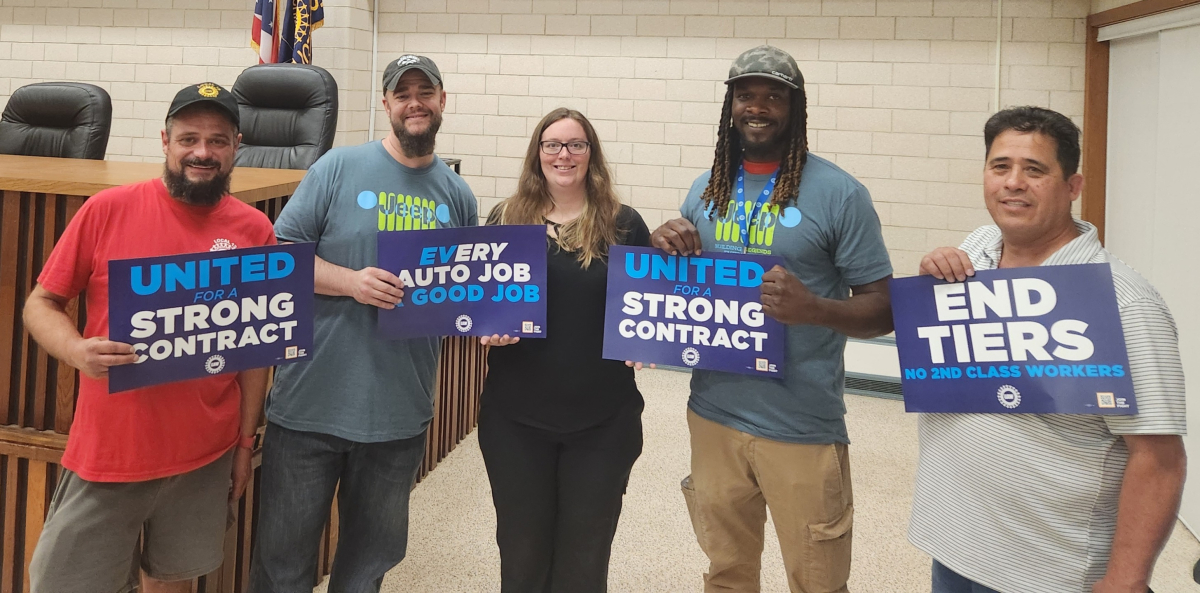A problematic two-tier clause exists in the current Tentative Agreement, and we wanted to share with you all the relevant information on why your union is against two-tiers.
As per the changes in the TA at 22.01 (b) and the LOA (page 5 and 6 of the Tenative Agreement Package) the former Child Protection 4.8% Premium will not apply to new hires in social work (including supervisors) working in Centralized Intake, After Hours Emergency Social Services, Family Group Conference Coordinator or Clinical Specialists in Child Welfare. All new hires doing these tasks will no longer get the 4.8%, yet employees currently doing these duties will continue to receive this amount. Download the info sheet (legal size) here: Why Two-Tiers are Bad
Why is CUPE fighting against two-tier deals?
“A two-tier contract provision offers a lesser condition of employment for certain employees than for others performing the same work, based solely on their date of hire. Two-tier provisions are always considered a concession, regardless of what may be negotiated in return.” – CUPE National Executive Board, NEB 2017
Tiers can be applied to the workforce as a whole or only target certain classifications. Over time, the number of workers in the lower tier will exceed that of the “grandfathered” workers. The employer saves money on the backs of the new hires, with the complicity of those hired before the two-tier deal. This creates different classes of workers: “haves” and “have nots” which hurts a local’s internal solidarity.

Where do those contracts come from?
In Canada, many employers have adopted tactics from the US private sector to cut labor costs and boost profits. Drawing from the 1980s, when US manufacturing moved overseas to exploit cheap labor and lax regulations, employers capitalized on fear to extract concessions from unions. Initially accepted as a temporary compromise, two-tier clauses undermined solidarity within US unions, alienating younger members and eroding support for seniority. This created a precedent for further employer demands, jeopardizing the interests of all workers, including retirees and future members, in favor of short-term gains.
CUPE has fought two-tier deals for over two decades
As two-tiers had been creeping up from the private sector to the Canadian public sector, delegates to CUPE’s 2011 National Convention adopted a strong resolution to launch a broad-based campaign to fight the imposition of two-tier contracts with lower wages, benefits, and working conditions, including an education component that highlights the additional impact two-tier contracts have on youth, equity-seeking groups, and non-unionized workers. In Québec, the labour movement was able to ban two-tier clauses on wages, as well as working hours, holidays, and training costs. Two-tiers have been illegal since 2001.
In December 2016, the National Executive Board approved a revised policy on collective bargaining that sets out a plan to ensure CUPE locals and members would be fully prepared to fight back against two-tier attacks during bargaining.
- The policy is automatically an integral part of any local’s strategic bargaining plan.
- The policy outlines the roles and responsibilities of all elected CUPE local leaders and staff in fighting concessions, resisting two-tier contract proposals from employers, and defending the free collective bargaining rights of CUPE members.
- The policy emphasizes the need to strengthen locals by mobilizing and engaging members to resist concessions in bargaining and build solidarity among locals.
- The policy outlines the importance of coordinating bargaining between locals, within sectors, and at the provincial level.
As the NEB states in the policy: “We have an obligation to our members to resist concessions, two-tier contract provisions, and precarious work. If a contract provision is not good enough for our current members, it is not good enough for the next generation of workers either.”
How two-tier contracts hurt workers and weaken unions
Union members in other locals have learned the hard way that two-tier contracts are poison. But these concessionary deals don’t just sell out the unborn. Two-tier contracts come back to bite workers on the top tier, too. Here are some of the worst impacts of two-tiers:
Divide and conquer
- In every workplace that has instituted two-tier systems, there is worker dissatisfaction because the lower-tier workers feel cheated that they are doing the same work as their co-workers but receiving less.
- Over time with new hiring waves, members in the top tier shrink to a small percentage of the workforce, and the majority becomes the lower tier. This causes internal conflict between union leaders and members and between members themselves.
Eroding union solidarity
- Unions get blamed for being complicit with the employer, damaging trust and credibility. This makes the local weaker and more vulnerable to concessions over the next rounds of bargaining.
- With a divided membership, it only gets harder to bargain hard or prepare for a strike when the trust has been broken with those hired after the two-tier deal.
Opening the door for employers to drive down union standards
- Two-tier contracts give employers an incentive to violate our contracts and direct work and overtime to lower-paid workers.
- Two-tier contracts put a target on the backs of older, higher-paid employees. In two-tiered sectors, members in the top tier become targets for discipline and termination by the managers who look to replace them with lower-paid new hires.
Contagious frustration
- Employee dissatisfaction leads to higher turnover, which means retraining, lower productivity, and higher workloads for those who remain. Workplace conflict and serious morale problems ensue.
- Contagion effect: Once tiers are set, employers often turn them into the “norm”, pushing it into other classifications or sectors.
Difficulty in reversal
- Once introduced, two-tier contracts are tough to reverse. Negotiations must then focus on undoing damage rather than making gains. Some unions have fought for nearly 10 years to eliminate two-tier deals. This came at a great cost in bargaining.
- Retirement insecurity: A resentful membership might be more inclined to conduct narrow, self-interested bargaining. The “screwed over” tier is more willing to take employer concessions on pension plans or benefits if it hurts more the retirees who “sold them out”.
Two-tier contracts are a strategic move by employers to weaken unions, divide workers, and drive down standards. We must reject these deals to protect our rights, our solidarity, and our future.
SO/nso: cope491
